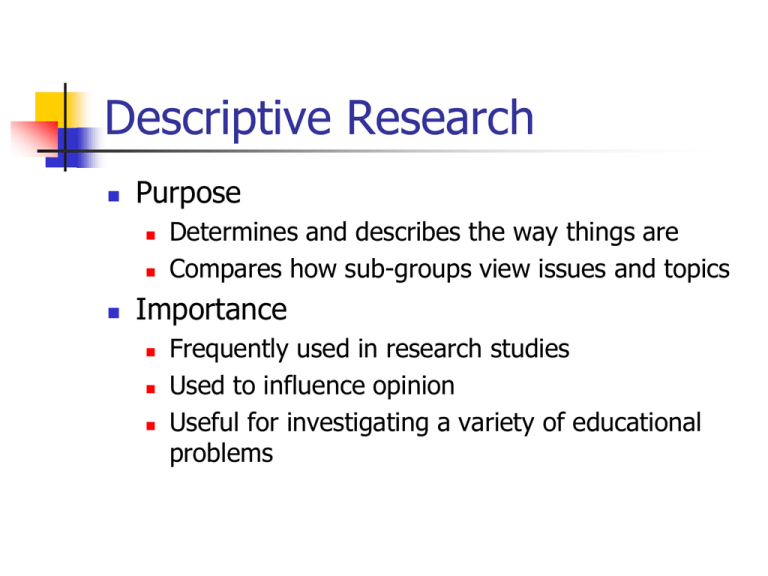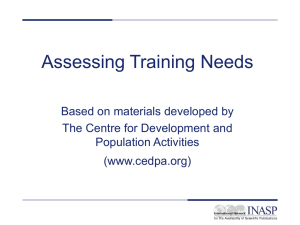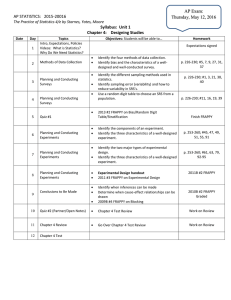summary descriptive
advertisement

Descriptive Research Purpose Determines and describes the way things are Compares how sub-groups view issues and topics Importance Frequently used in research studies Used to influence opinion Useful for investigating a variety of educational problems Differences from Qualitative Research Descriptive Research Uses observations and interviews Studies the topic from the researcher’s perspective Qualitative Research Uses observations and interviews Studies the topic from the participant’s perspective Method Six steps in conducting descriptive research Identify problem Review literature Select participants and instruments Collect valid and reliable data Analyze data Report conclusions Common Errors Lack of participant response Low response rates are common Difficulties interpreting the findings without the data representing non-respondents’ views Unclear/ambiguous items Researcher needs to develop recording forms that collect the data objectively and reliably Classifications of Descriptive Research • Classified by how data are collected • Self-report • • Individuals respond to statements or questions about themselves Observation • Data is collected by the researcher watching participants Survey Data Collection Methods Surveys represent the most common type of self-report measures Questionnaires Interviews Advantages of conducting surveys Less time is required Less expenses are incurred Larger samples can be used Survey Data Collection Methods Five (5) types of surveys School surveys Information collected by a school Information collected about a school Sample surveys Use of samples representing relevant subgroups of interest Survey Data Collection Methods Developmental surveys Examining variables that differentiate children at different developmental stages Cross-sectional surveys Collecting data from several samples at one point in time Surveying samples of elementary, middle, and secondary teachers at the same time Survey Data Collection Methods Longitudinal surveys Collecting data at two or more times to measure change Four types Trend – samples from succeeding groups are studied over time Cohort – separate samples from a single group are studied over time Panel – a single sample from a group is studied over time Follow-up – a sample is studied after the formal study is complete Conducting Survey Research State the problem The topic must be of sufficient significance to motivate a respondent and justify the research effort Select the participants Must be able to provide the desired information Must be willing to participate Conducting Survey Research Constructing the questionnaire Appearance Visually attractive – use of white space Brief Carefully planned content and item formats Clearly identify sub-topics Use structured items if possible Use responses that can be checked or circled rather than written Conducting Survey Research Methods to collect data Mailed surveys Advantages – efficient, inexpensive, easily standardized, easy to score, anonymous or confidential Disadvantages – low response rate, inability to probe E-mailed surveys Advantages – quick, efficient, inexpensive, easily standardized, easy to score Disadvantages – can only assure confidentiality, respondents might not have access to e-mail Conducting Survey Research Telephone surveys Personal administration Advantages – high response rates, efficient Disadvantages – requires lists of telephone numbers, requires training Advantages – efficient if respondents are in close proximity to the administrator, allows for probes Disadvantages – time consuming, expensive, requires training Personal interview Advantages – rich complete responses Disadvantages – little standardization, takes time to administer, expensive Conducting Survey Research Types of items Two approaches to writing an item Structured items – closed-ended, selection Unstructured – open-ended, supply Two disadvantages are that respondents will not take the time to respond and the responses are difficult to score objectively Specific types Scales Likert Semantic differential Rankings Checklists Free responses Conducting Survey Research Qualities of good items Address single concept Avoid jargon Include point of reference Avoid leading questions Avoid sensitive questions Do not assume facts not necessarily true Pretested Provide information on how to respond Questionnaire design Do not crowd items Number pages and items Do not put important questions at the end Conducting Survey Research Constructing a cover letter Explains what is being asked and why Content A brief description of the study Contact information Organizational endorsements and support Deadline for responding Stamped self-addressed return envelope Conducting Survey Research Cover Letter Characteristics Is brief, neat, and personalized Gives reason to respond Gives means to respond Promises anonymity or confidentiality Anonymity and confidentiality Anonymity means no one can trace the respondent to his or her responses Confidentiality means the researcher knows who responded but promises not to divulge that information Used to track respondents and non-respondents Usually ensured by coding names when the data is entered Conducting Survey Research Pretest the questionnaire Reviews by three (3) or four (4) individuals Provides information about deficiencies and suggestions for improvement Follow-up activities Reminder postcard Second survey with a cover letter politely requesting a response Telephoning a small sample of non-respondents Conducting Survey Research Two types of non-responses Respondents not returning the survey First mailings usually result in 30% - 50% response rate Follow-up postcards usually add about 20% Sending a second survey with a polite cover letter requesting participation usually adds about 10% Conducting Survey Research Respondents not returning the survey (cont.) Concerns with generalizing from the results of the respondents given the lack of information from the non-respondents Use of telephone interviews to collect responses from a few non-respondents Comparing these responses to those of the respondents Comparing respondents and non-respondents on demographic variables to ascertain any systematic differences Conducting Survey Research Two types of non-responses (cont.) Respondents not completing items Be certain this is taken into account when summarizing scores Simply adding scores will not reflect the true score of a participant if he or she has left some items blank Averaging those items to which a participant has responded takes into account his or her blank responses Conducting Survey Research Tabulating responses Closed-ended items Scantrons Electronic spreadsheets (e.g., Excel) Statistical software (e.g., SPSS-Windows) Open-ended items Code answers according to perceived patterns Conducting Survey Research Analyzing results Total sample size and return rate Responses to each item Subscale scores Average score and percentage of the sample responding Average score of items on the subscale Total score Average score of all items Conducting Interviews An interview is the oral, in-person administration of a questionnaire to each member of a sample. Interview Studies Advantages More in-depth Flexible Gives opportunity to establish rapport Allows immediate follow-up Disadvantages May be biased by interviewer Time-consuming and expensive Requires skill Conducting Interview Research Define the problem Identify potential interviewees Construct an interview guide A written protocol that indicates what questions are to be asked, in what order, and how much prompting and probing is permitted Conducting Interview Research Interview Guide (continued) Assures that all interviews will be conducted in the same manner Generally uses semi-structured and unstructured items Pretest the interview Identifies deficiencies and suggests improvements Conducting Interview Research Administer the interview Conducting an interview effectively requires training, effective communication skills, and good interpersonal skills Guidelines Be as brief as possible Explain terms that the interviewee might not understand Do not use leading questions Do more listening and less talking Conducting Interview Research Record the responses Manually recording Cumbersome and slow Likely to miss important information Mechanical recording Cassette tapes and videos Captures most, if not all, of the information Permits reviewing of the information Causes potential discomfort on the interviewee’s part Can malfunction Obj. 5.7







